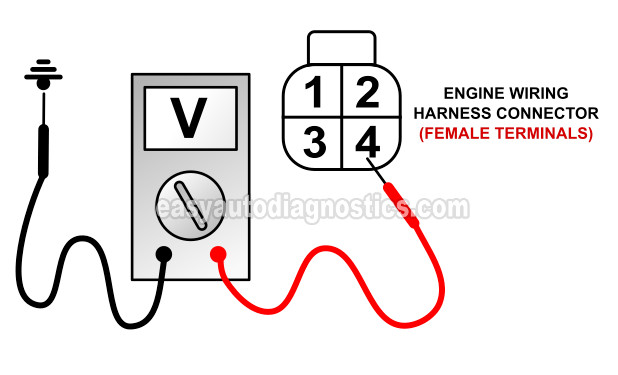
Testing a trouble code P0141 on your 1996-1997 Nissan Pickup is pretty easy. In a nutshell, all that's involved is making sure that the rear O2 sensor's heater element is getting power and then verifying that its resistance is within specification.
In this tutorial, I'll show how in a step-by-step way! By the way, you don't need a scan tool since troubleshooting the O2 sensor's heater can be done with a simple multimeter.
Contents of this tutorial:
![]() You can find this tutorial in Spanish here: Probando El Calentador Del Sensor De Oxígeno -P0141 (1996-1997 2.4L Nissan Pick Up) (at: autotecnico-online.com).
You can find this tutorial in Spanish here: Probando El Calentador Del Sensor De Oxígeno -P0141 (1996-1997 2.4L Nissan Pick Up) (at: autotecnico-online.com).
NOTE: If you need to test the front oxygen sensor's heater (trouble code P0135), see the following tutorial: Oxygen Sensor Heater Test -P0135 (1996-1997 2.4L Nissan Pickup).
Circuit Descriptions Of The Downstream Oxygen Sensor

As you're already aware, the rear oxygen sensor has 4 wires sticking out of its connector.
In the table below, you'll find the color of the wires and a brief description of the 4 wires of the rear oxygen sensor's engine wiring harness connector.
The engine wiring harness connector has female terminals, while the connector on the rear oxygen sensor itself has male spade terminals.
Here's a brief description of the 4 wires of the rear oxygen sensor:
| Downstream Oxygen Sensor Pinout (1996-1997 2.4L Nissan Pickup) | ||
|---|---|---|
| Pin | Wire Color | Description |
| 1 | GRN/RED | Heater Ground (-) |
| 2 | BLK | O2 Signal |
| 3 | GRY | O2 Signal Ground |
| 4 | WHT | Heater Power (+) |
Where To Buy The Oxygen Sensor And Save Some $
The following links will help you to save some bucks on the rear oxygen sensor:
NOTE: If you're not sure if the above downstream O2 sensor fits your particular 2.4L Nissan Pickup, don't worry, once you get to the site, they'll make sure the sensor is the right one, if not, they'll find you the right one.
TEST 1: Making Sure The O2 Sensor's Heater Is Getting Power

To find out if the rear oxygen sensor's heater is bad or not, we'll start off by making sure that the O2 sensor's heater is getting 10 to 12 Volts.
The white (WHT) wire (of the engine wiring harness connector) is the one that feeds the O2 sensor heater with these 10 to 12 Volts.
CAUTION: The oxygen sensor gets and stays very hot even after the engine is off! Perform this test with a completely cold engine. Be careful and take all necessary safety precautions! If you raise your vehicle with a jack, place it on jack stands!
IMPORTANT: The pinout in the illustration above is of the connector on the oxygen sensor itself. To check for power, you'll test the wire that belongs to the engine wiring harness sensor connector.
OK, this is what you'll need to do:
- 1
Locate the downstream oxygen sensor and disconnect it from its engine wiring harness connector.
- 2
Set your multimeter to Volts DC mode.
- 3
Turn the key to the ON position but don't crank or start the engine (this will power up the O2 sensor's engine wiring harness connector).
- 4
Connect the red multimeter test lead (with the appropriate tool) to the white wire of the engine wiring harness connector.
NOTE: The engine wiring harness connector has female terminals. - 5
Turn the key on but don't crank or start the engine.
- 6
Your multimeter should register 10 to 12 Volts DC.
Let's take a look at your test results:
CASE 1: Your multimeter registered 10 to 12 Volts DC. This is the correct test result and it confirms that the rear oxygen sensor's heater element is getting power.
The next step is to verify that the heater's resistance is within specification. For this test, go to: TEST 2: Testing The Heater Element's Resistance.
CASE 2: Your multimeter DID NOT register 10 to 12 Volts DC. The most likely cause of this missing voltage is due to a blown fuse or a short (or open) in the wiring. You'll need to check fuse #9 (15 amps) in the fuse box and make sure it's not blown.
If the fuse is OK, your next step is to find out why these 12 Volts are missing using a wiring diagram.




